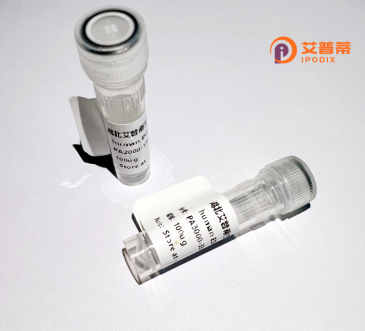
| 纯度 | >90%SDS-PAGE. |
| 种属 | Human |
| 靶点 | DPM3 |
| Uniprot No | Q9P2X0 |
| 内毒素 | < 0.01EU/μg |
| 表达宿主 | E.coli |
| 表达区间 | 1-122aa |
| 氨基酸序列 | MLSVGGLRLSLVRFSFLLLRGALLPSLAVTMTKLAQWLWGLAILGSTWVALTTGALGLELPLSCQEVLWPLPAYLLVSAGCYALGTVGYRVATFHDCEDAARELQSQIQEARADLARRGLRF |
| 分子量 | 39.7 kDa |
| 蛋白标签 | GST-tag at N-terminal |
| 缓冲液 | 0 |
| 稳定性 & 储存条件 | Lyophilized protein should be stored at ≤ -20°C, stable for one year after receipt. Reconstituted protein solution can be stored at 2-8°C for 2-7 days. Aliquots of reconstituted samples are stable at ≤ -20°C for 3 months. |
| 复溶 | Always centrifuge tubes before opening.Do not mix by vortex or pipetting. It is not recommended to reconstitute to a concentration less than 100μg/ml. Dissolve the lyophilized protein in distilled water. Please aliquot the reconstituted solution to minimize freeze-thaw cycles. |
以下是关于重组人DPM3蛋白的3篇参考文献及其摘要内容:
1. **文献名称**:*Structural and functional analysis of the human DPM3-DPM1B complex required for glycosylphosphatidylinositol biosynthesis*
**作者**:Kinoshita, T., et al.
**摘要**:本研究通过重组表达人源DPM3与DPM1B蛋白复合物,解析了其晶体结构,揭示了DPM3在稳定DPM1B活性及调控糖基磷脂酰肌醇(GPI)锚定生物合成中的关键作用,为相关先天性糖基化疾病提供了分子机制解释。
2. **文献名称**:*Recombinant expression of human DPM3 in yeast identifies essential residues for enzymatic activity*
**作者**:Maeda, Y., et al.
**摘要**:作者利用酵母表达系统成功制备重组人DPM3蛋白,通过定点突变筛选出影响其与DPM1亚基结合的关键氨基酸位点,阐明了DPM3在甘露糖转移酶复合体中的功能特异性。
3. **文献名称**:*Defective DPM3 disrupts dolichol-phosphate mannose synthesis causing muscular dystrophy*
**作者**:Barone, R., et al.
**摘要**:研究通过重组DPM3蛋白功能实验,证明DPM3突变导致多萜醇磷酸甘露糖合成异常,进而引发肌营养不良症状,为疾病的诊断和靶向治疗提供了生化依据。
以上研究均聚焦于重组DPM3蛋白在糖基化途径中的结构、功能及疾病关联,涵盖基础机制和临床转化方向。
Recombinant human DPM3 protein is a key component in the biosynthesis of glycoproteins and glycolipids, essential for cellular functions. DPM3 (Dolichol-phosphate-mannose synthase subunit 3) forms a complex with DPM1 and DPM2 to synthesize dolichol-phosphate-mannose (Dol-P-Man), a critical sugar donor in N-linked and O-linked glycosylation processes. This post-translational modification is vital for protein folding, stability, and cellular interactions. DPM3 acts as a stabilizer and regulatory subunit, anchoring DPM1 (the catalytic subunit) to the endoplasmic reticulum membrane via its interaction with DPM2. Defects in DPM3 disrupt Dol-P-Man synthesis, leading to congenital disorders of glycosylation (CDGs), characterized by multisystem abnormalities, including neurological and developmental impairments.
Recombinant DPM3 is produced using expression systems like *E. coli* or mammalian cells, enabling studies on its structural and functional roles in glycosylation. It aids in elucidating molecular mechanisms of CDGs and serves as a tool for drug discovery or gene therapy targeting glycosylation deficiencies. Research on recombinant DPM3 also contributes to understanding metabolic pathways and ER stress responses linked to glycosylation defects. Its applications extend to diagnostics, enzyme replacement strategies, and functional assays to assess pathogenic mutations' impact on cellular health.
×